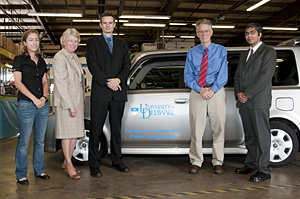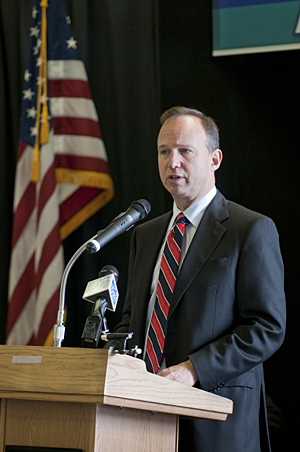
- Rozovsky wins prestigious NSF Early Career Award
- UD students meet alumni, experience 'closing bell' at NYSE
- Newark Police seek assistance in identifying suspects in robbery
- Rivlin says bipartisan budget action, stronger budget rules key to reversing debt
- Stink bugs shouldn't pose problem until late summer
- Gao to honor Placido Domingo in Washington performance
- Adopt-A-Highway project keeps Lewes road clean
- WVUD's Radiothon fundraiser runs April 1-10
- W.D. Snodgrass Symposium to honor Pulitzer winner
- New guide helps cancer patients manage symptoms
- UD in the News, March 25, 2011
- For the Record, March 25, 2011
- Public opinion expert discusses world views of U.S. in Global Agenda series
- Congressional delegation, dean laud Center for Community Research and Service program
- Center for Political Communication sets symposium on politics, entertainment
- Students work to raise funds, awareness of domestic violence
- Equestrian team wins regional championship in Western riding
- Markell, Harker stress importance of agriculture to Delaware's economy
- Carol A. Ammon MBA Case Competition winners announced
- Prof presents blood-clotting studies at Gordon Research Conference
- Sexual Assault Awareness Month events, programs announced
- Stay connected with Sea Grant, CEOE e-newsletter
- A message to UD regarding the tragedy in Japan
- More News >>
- March 31-May 14: REP stages Neil Simon's 'The Good Doctor'
- April 2: Newark plans annual 'wine and dine'
- April 5: Expert perspective on U.S. health care
- April 5: Comedian Ace Guillen to visit Scrounge
- April 6, May 4: School of Nursing sponsors research lecture series
- April 6-May 4: Confucius Institute presents Chinese Film Series on Wednesdays
- April 6: IPCC's Pachauri to discuss sustainable development in DENIN Dialogue Series
- April 7: 'WVUDstock' radiothon concert announced
- April 8: English Language Institute presents 'Arts in Translation'
- April 9: Green and Healthy Living Expo planned at The Bob
- April 9: Center for Political Communication to host Onion editor
- April 10: Alumni Easter Egg-stravaganza planned
- April 11: CDS session to focus on visual assistive technologies
- April 12: T.J. Stiles to speak at UDLA annual dinner
- April 15, 16: Annual UD push lawnmower tune-up scheduled
- April 15, 16: Master Players series presents iMusic 4, China Magpie
- April 15, 16: Delaware Symphony, UD chorus to perform Mahler work
- April 18: Former NFL Coach Bill Cowher featured in UD Speaks
- April 21-24: Sesame Street Live brings Elmo and friends to The Bob
- April 30: Save the date for Ag Day 2011 at UD
- April 30: Symposium to consider 'Frontiers at the Chemistry-Biology Interface'
- April 30-May 1: Relay for Life set at Delaware Field House
- May 4: Delaware Membrane Protein Symposium announced
- May 5: Northwestern University's Leon Keer to deliver Kerr lecture
- May 7: Women's volleyball team to host second annual Spring Fling
- Through May 3: SPPA announces speakers for 10th annual lecture series
- Through May 4: Global Agenda sees U.S. through others' eyes; World Bank president to speak
- Through May 4: 'Research on Race, Ethnicity, Culture' topic of series
- Through May 9: Black American Studies announces lecture series
- Through May 11: 'Challenges in Jewish Culture' lecture series announced
- Through May 11: Area Studies research featured in speaker series
- Through June 5: 'Andy Warhol: Behind the Camera' on view in Old College Gallery
- Through July 15: 'Bodyscapes' on view at Mechanical Hall Gallery
- More What's Happening >>
- UD calendar >>
- Middle States evaluation team on campus April 5
- Phipps named HR Liaison of the Quarter
- Senior wins iPad for participating in assessment study
- April 19: Procurement Services schedules information sessions
- UD Bookstore announces spring break hours
- HealthyU Wellness Program encourages employees to 'Step into Spring'
- April 8-29: Faculty roundtable series considers student engagement
- GRE is changing; learn more at April 15 info session
- April 30: UD Evening with Blue Rocks set for employees
- Morris Library to be open 24/7 during final exams
- More Campus FYI >>
1:21 p.m., Sept. 22, 2009----The University of Delaware was a major player at a Monday, Sept. 21, event that marked the launch of the first vehicle-to-grid (V2G) electric cars made in Delaware and the signing of Senate Bill 153 by Gov. Jack A. Markell, which rewards owners of V2G technology for plugging in.
The event was held at AutoPort Inc. near Wilmington, which retrofitted a Toyota Scion that was on display. Another star of the show was the University of Delaware's eBox V2G vehicle, which was developed by vehicle-to-grid pioneer Willett Kempton, professor in the College of Earth, Ocean, and Environment (CEOE).
The bill, which Markell said was the first of its kind in the world, compensates owners of electric cars for electricity sent back to the grid at the same rate they pay for electricity to charge the battery.
V2G vehicles work like an electrical sponge, capable of absorbing excess energy when demand for power is low, and returning some back to the electric grid when the demand for power is high. The new law lets people take advantage of this unique ability by requiring owners providing V2G services be “net metered,” meaning they only pay for the net amount of electricity they draw.
While the vehicles do not generate electricity like solar panels or wind turbines, their ability to provide electricity back to the electric grid means at times V2G customers' meters will actually run backwards.
“This technology improves the electric system by providing balancing power via storage that would otherwise require burning fossil fuels to produce,” Kempton said.
In addition to Kempton, UD was represented at the event by CEOE Dean Nancy Targett; graduate student Jon Lilley, who coordinated the UD project; postdoctoral computer scientist Sachin Kamboj, who worked on programming the car; and UD alumna Sarah O'Neill, who works for AC Propulsion in California, which makes the electric drive system and designed the car.
Roy Kirchner, president of AutoPort, which received a grant from the Delaware Economic Development Office to train workers to retrofit V2G vehicles, welcomed the group of about 50 people, calling the project “another first for the First State,” and introduced the governor.
Markell paid tribute to Kempton, whom he said he met five years ago when Kempton first told him about his project. It is “amazing but here we are,” Markell said, thanking Kempton for his “continuing education.”
After the signing of the bill, the keys were given to a representative of Pepco Holdings, the Delmarva Power parent company that supported the vehicle's development, and there was a ribbon cutting ceremony as the V2G car emerged from the AutoPort building.
The legislation, Senate Bill 153, was sponsored by Sen. F. Gary Simpson, R-Milford. It was co-sponsored by Energy and Transit Committee Chair Sen. Harris B. McDowell III, D-Wilmington North; Sen. Liane Sorenson, R-Hockessin; Sen. David Sokola, D-Newark; and Rep. Gerald W. Hocker, R-Ocean View. It was also sponsored by John Kowalko, D-Newark South.
The University of Delaware's Office of Economic Innovation and Partnerships is exploring a partnership with AutoPort to provide technology rights and assistance to incorporate V2G patented technology in the conversion of gas powered to all electric vehicles.
Article by Sue Moncure
Photos by Evan Krape



